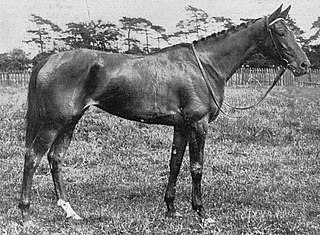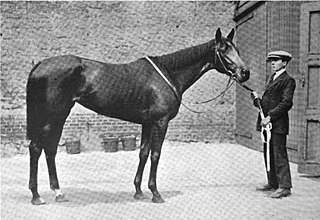
Beam was a British Thoroughbred racehorse and broodmare. As a juvenile she showed promise by winning one race and finishing third in the Molecomb Stakes. In the following year she finished fourth in the 1000 Guineas and won the Haverhill Stakes before beating a strong field to take the Epsom Oaks in a race record time which stood for more than half a century. She was retired from racing at the end of the season. Beam made no impact as a dam of winners and died in 1941 at the age of seventeen.
Brownhylda was a British Thoroughbred racehorse and broodmare. She showed considerable promise as a two-year-old when she won three times and finished twice on two occasions. In the following year he won the Epsom Oaks and the Park Hill Stakes as well as finishing second in the Yorkshire Oaks. Her form declined thereafter and she failed to win again before being retired at the end of the following year. She produced only four known foals, but these did include the St Leger winner Firdaussi.

Pogrom was a British Thoroughbred racehorse and broodmare. As a two-year-old in 1921 she showed considerable promise by winning four of her six starts. In the following year she was one of the best fillies of her generation as she won the Epsom Oaks, Coronation Stakes and Newmarket Oaks and finished second on three other occasions. She made very little impact as a broodmare and died in 1933.

Love in Idleness was a British Thoroughbred racehorse and broodmare. Her diminutive stature and courageous racing style made her one of the most popular horses of her time. She showed very promising form as a two-year-old in 1920 when she won four time from five starts. In the following year she was arguably the best three-year-old filly in England as she won the Epsom Oaks, Sandringham Stakes, Yorkshire Oaks and Park Hill Stakes. After retiring from racing he had some success as a dam of winners.
Bayuda was a British Thoroughbred racehorse and broodmare. As a two-year-old in 1918 she won the Cheveley Park Stakes and was placed in several other races against male opposition. In the following year she was beaten in the 1000 Guineas before recording an upset victory in the Epsom Oaks. Her racing career was ended by injury later that year. As a broodmare she produced very few foals, but exerted an enduring influence on the breed as the female-line ancestor of Sharpen Up.

Sunny Jane was a British Thoroughbred racehorse and broodmare. She was slow to mature and finished unplaced on her only start as a two-year-old in 1916. Her second season was dominated by her rivalry with the brilliantly fast filly Diadem. Sunny Jane was narrowly beaten by her rival in the 1000 Guineas but reversed the form over a longer distance to win the New Oaks. She won one other race but lost her form in the autumn and was retired from racing. As a broodmare she produced few winners but exerted an enduring influence through her daughter Miss Cavendish.

Princess Dorrie was a British Thoroughbred racehorse and broodmare. As a two-year-old in 1913 she failed to win a race but was very consistent, finishing placed in seven of her eight starts. In the following year she was probably the best three-year-old filly in England, winning both the 1000 Guineas and the Epsom Oaks. She was retired at the end of the 1914 season and had modest success as a broodmare.

Our Lassie was a British Thoroughbred racehorse and broodmare. She was a very good performer as a juvenile in 1902 when she won the Sandown Produce Stakes and was placed in her other three starts. In the following year she failed in the Lincoln Handicap but the recorded a decisive win in the Oaks Stakes. She failed to win or place in four subsequent races and was retired from racing at the end of 1904. As a broodmare she produced a few winners but had her biggest impact on the future of Thoroughbred racing through her unraced daughter Lady Brilliant.

Keystone was a British Thoroughbred racehorse and broodmare. Having suffered from ill-health as a juvenile she recorded an emphatic win in the Epsom Oaks on her second racecourse appearance. She went on to win the Coronation Stakes and three other races as well as finishing second in the Jockey Club Stakes and a possibly unlucky fourth in the St Leger. She failed to win in the following year and was retired from racing. As a broodmare she produced the St Leger winner Keysoe and was the female-line ancestor of Display and Ballymoss.

Perola was a British Thoroughbred racehorse and broodmare. She was one of the best juvenile fillies in England in 1908 when she won four of her seven races, including the Woodcote Stakes, as well as being placed behind Bayardo in both the New Stakes and the Dewhurst Stakes. In the following year she finished third in the 1000 Guineas and then recorded her biggest win in the Oaks Stakes. In early 1910 she was sold and exported to France to become a broodmare.

Cap and Bells was an American-bred Thoroughbred racehorse and broodmare. After showing promising form in the United States as a juvenile in 1900 she was set to race in England. In June 1901 on her British debut she recorded an extraordinary win in the Epsom Oaks, becoming the first American horse to do so. She never recaptured her Epsom form and was retired from racing in 1903. After returning to United States she had some success as a broodmare.

Tranquil was a British Thoroughbred racehorse and broodmare. She showed considerable promise as a two-year-old when she won one race and finished second in the Gimcrack Stakes. In the following season she was one of the best horses in Britain, scoring classic victories in the 1000 Guineas and St Leger Stakes as well as winning four other races including the Jockey Club Cup and Newmarket Oaks. She won once in 1924 before her racing career was ended by injury. She made no impact as a broodmare.
Keysoe (1916–1929) was a British Thoroughbred racehorse and broodmare. Bred and owned by the 17th Earl of Derby she was the product of a mating between two St Leger winners and won the race herself in 1919. She was unraced as a juvenile but developed into a top-class stayer at three, winning the Gratwicke Stakes and the Nassau Stakes at Goodwood Racecourse before taking the St Leger and later winning the Newmarket Oaks. She failed to win as a four-year-old in 1920 although she was placed in all of her races. After her retirement from racing, she had considerable success as a broodmare despite producing very few foals.

Brown Betty was a British Thoroughbred racehorse and broodmare. She was one of the best of an exceptional crop of juvenile fillies in 1932 when she won her last four races including the Cheveley Park Stakes. In the following spring he recorded her biggest victory when she took the 1000 Guineas. She ran disappointingly when fourth in the Epsom Oaks but went on to win the Richemount Stakes and finished second in both the Nassau Stakes and the Park Hill Stakes. She was retired from racing at the end of her second season and exported to become a broodmare in the United States.
Four Course was a British Thoroughbred racehorse. She was one of the best two-year-old fillies of her generation in England when she won three of her four races, namely the July Stakes, Richmond Stakes and Gimcrack Stakes. In the following spring she won the 1000 Guineas and finished second in both the Epsom Oaks and the Falmouth Stakes. She was retired at the end of the year but died before she could make and mark as a broodmare.
Fair Isle was a British Thoroughbred racehorse and broodmare. She was the top-rated juvenile filly in England in 1929 when she won three of her five races, namely the Champion Breeders' Foal Plate, Buckenham Post Produce Stakes and Bretby Stakes. In the following year she won the 1000 Guineas and Midsummer Stakes as well as finishing fourth in the Epsom Oaks and third in the Champion Stakes. All but one of Fair Isle's wins came at Newmarket Racecourse. As a broodmare, the best of her foals was the Queen Anne Stakes winner St Magnus.
Silver Urn was an Irish-bred, British-trained Thoroughbred racehorse and broodmare. As a two-year-old she showed little ability but in the following spring she won two valuable handicap races and then recorded her biggest win in the 1000 Guineas. On her next appearance she sustained career-ending injuries in the Epsom Oaks and never raced again. She had some success as a dam of winners.
Roseway was a British Thoroughbred racehorse and broodmare. She showed promise as a juvenile in 1918 when she won twice and was second twice from seven starts. In the following spring she produced by far her best performance when she won the 1000 Guineas by six lengths. She finished second when odds-on favourite for the Oaks Stakes but ran poorly in two subsequent races and was retired from racing at the end of the year. She had some success as a broodmare both in Britain and in the United States.

Winifreda was a British Thoroughbred racehorse and broodmare. After winning the Richmond Stakes on her only start as a juvenile she took the 1000 Guineas on her three-year-old debut. She disappointed when favourite for the Epsom Oaks but returned to form to win the Coronation Stakes at Royal Ascot. Her career was then interrupted by health problems and she was well beaten in two subsequent races. She made no impact as a broodmare.

Sibola (1896–1921) was an American-bred, British-trained Thoroughbred racehorse and broodmare. She was sent to England as a yearling and showed some promise as a two-year-old in 1898 although she failed to win a race. In the following year, she was the most successful filly of her age in England, taking the Wood Ditton Stakes, 1000 Guineas, Derby Biennial Foal Stakes and Scarborough Stakes as well as finishing a close and unlucky second in the Epsom Oaks. She remained in training until the age of five but never recovered her best form. As a broodmare she had an enduring influence on the breed as the female-line ancestor of Nearco.













